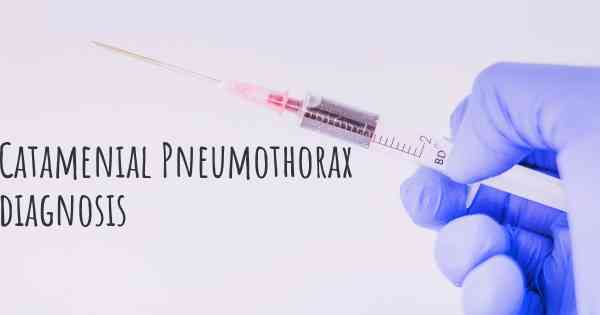How is Catamenial Pneumothorax diagnosed?
See how Catamenial Pneumothorax is diagnosed. Which specialists are essential to meet, what tests are needed and other useful information for the diagnosis of Catamenial Pneumothorax

Diagnosis of Catamenial Pneumothorax
Catamenial pneumothorax is a rare condition characterized by the presence of air or gas in the pleural cavity of the lungs during menstruation. It is a form of spontaneous pneumothorax that occurs in women of reproductive age. Diagnosis of catamenial pneumothorax can be challenging due to its rarity and the similarity of symptoms with other lung conditions. However, there are several diagnostic methods that can help identify and confirm the presence of catamenial pneumothorax.
Medical History and Physical Examination
The first step in diagnosing catamenial pneumothorax is a thorough medical history and physical examination. The healthcare provider will ask about the patient's symptoms, including the timing of pneumothorax episodes in relation to menstruation. They will also inquire about any previous episodes of pneumothorax and any relevant medical conditions. During the physical examination, the healthcare provider will listen to the patient's lungs using a stethoscope to check for abnormal breath sounds, such as decreased breath sounds or wheezing, which may indicate a pneumothorax.
Chest X-ray
A chest X-ray is commonly the first imaging test performed to evaluate a suspected pneumothorax. It can help visualize the presence of air or gas in the pleural cavity. In catamenial pneumothorax, the X-ray may show a collapsed lung or a partial lung collapse. However, it is important to note that a normal chest X-ray does not rule out the possibility of catamenial pneumothorax, as small or intermittent pneumothoraces may not be visible on X-ray.
Computed Tomography (CT) Scan
A CT scan is a more sensitive imaging test that can provide detailed images of the lungs and pleural cavity. It can help identify small or subtle pneumothoraces that may not be visible on a chest X-ray. CT scans can also help determine the location and extent of the pneumothorax, as well as any associated lung abnormalities. In catamenial pneumothorax, CT scans may reveal diaphragmatic endometriosis, which is a common underlying cause of the condition.
Video-Assisted Thoracoscopy (VATS)
VATS is a minimally invasive surgical procedure that allows direct visualization of the pleural cavity and lung surfaces. It is considered the gold standard for diagnosing catamenial pneumothorax. During VATS, a small incision is made in the chest wall, and a thin, flexible tube with a camera (thoracoscope) is inserted to examine the pleural cavity. This procedure enables the healthcare provider to directly visualize any abnormalities, such as endometrial implants or diaphragmatic defects, which are characteristic findings in catamenial pneumothorax.
Hormonal Evaluation
Since catamenial pneumothorax is associated with hormonal fluctuations during menstruation, hormonal evaluation may be performed to support the diagnosis. Blood tests can measure hormone levels, such as estrogen and progesterone, during different phases of the menstrual cycle. However, it is important to note that hormonal evaluation alone is not sufficient to diagnose catamenial pneumothorax, as hormone levels can vary among individuals.
Other Diagnostic Tests
In some cases, additional diagnostic tests may be performed to rule out other potential causes of pneumothorax and to evaluate the overall lung function. These tests may include:
- Pulmonary Function Tests (PFTs): These tests measure lung capacity and function, helping to assess the overall respiratory health.
- Thoracentesis: This procedure involves removing a sample of fluid or air from the pleural cavity using a needle for laboratory analysis.
- Magnetic Resonance Imaging (MRI): MRI scans can provide detailed images of the chest and help identify any structural abnormalities or endometrial implants.
- Biopsy: In rare cases, a biopsy may be performed to obtain a tissue sample for further analysis, especially if other lung conditions are suspected.
Conclusion
Diagnosing catamenial pneumothorax requires a comprehensive approach that includes a detailed medical history, physical examination, and various diagnostic tests. While chest X-rays and CT scans can provide valuable information, VATS remains the most reliable method for confirming the diagnosis. Hormonal evaluation and other tests may also be used to support the diagnosis and rule out other potential causes. Early and accurate diagnosis is crucial for appropriate management and treatment of catamenial pneumothorax.








